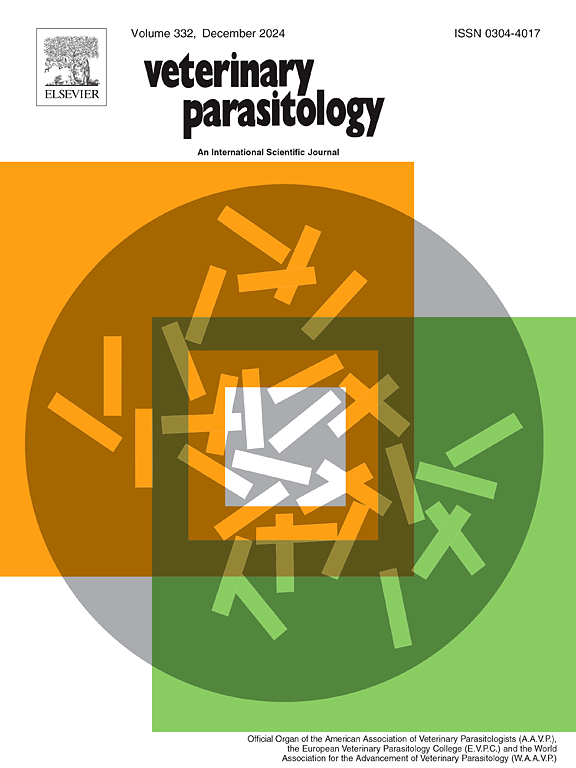Efficacy of a combination of nucleotides and lactoferrin in maintaining stable or improving the clinical picture and laboratory findings of leishmaniotic dogs: A randomized controlled study
IF 2
2区 农林科学
Q2 PARASITOLOGY
引用次数: 0
Abstract
This prospective, randomized, controlled, therapeutic study aimed to evaluate the efficacy of a product containing nucleotides and lactoferrin in maintaining or improving the clinical picture and laboratory findings of canine leishmaniosis (CanL). The safety and tolerance of this combination were also assessed. Forty Leishmania infantum-seropositive dogs, not requiring leishmanicidal and/or leishmaniostatic treatment, were enrolled in the study and randomized into treatment (TG) and placebo (CG) groups. Products A (containing nucleotides and lactoferrin) and B (placebo) were blindly administered to TG and CG, respectively, as palatable tablets at a rate of 1 tablet per 10 kg of weight once every 24 h for 6 months. Following inclusion (T0), dogs were followed up after 3 (T90) and 6 (T180) months. At each time point, for all animals enrolled physical examination and laboratory tests (complete blood count, biochemical panel including C-reactive protein [CRP] and ferritin, and serum protein electrophoresis) were performed. The immunofluorescence antibody test to detect antibodies for L. infantum (T0, T180), Ehrlichia canis (T0, T90, and T180), and Anaplasma phagocytophilum (T0, T90, and T180) was executed. A CanL-dedicated clinical score, using a validated scale from 0 (i.e., absence of clinical signs) to 19, was assigned. Four dogs (n=2 in TG, n=2 in CG) did not complete the study. No statistically significant differences in CanL clinical score were observed between CG and TG at T0, T90 and T180. Both TG and CG showed significant variations in anti-L. infantum antibody titres (p=0.0001 and p=0.004, respectively). In TG, antibody titres decreased in 77.8 %, increased in 5.5 %, and remained stable in 16.7 % of dogs, while in CG, decreased in 27.8 %, increased in 50 %, and remained stable in 22.2 % of dogs. During the study, CRP and ferritin remained stable in TG and significantly increased in CG. At T180, 9 out of 18 dogs (50 %) enrolled in the CG, and 1 out of 18 (5.6 %) enrolled in the TG, developed an active form of leishmaniosis. No side effects were reported in any patient included. In conclusion, a 6-month oral administration of a supplement containing nucleotides and lactoferrin was effective in maintaining a stable clinical score, improving antibody titres and potentially reducing the progression from non-active to active forms in L. infatum seropositive dogs. Furthermore, the product was well-tolerated, easy to administer, and free of side effects.
核苷酸和乳铁蛋白联合疗法在维持利什曼病犬临床症状和实验室结果稳定或改善方面的疗效:随机对照研究。
这项前瞻性随机对照治疗研究旨在评估一种含有核苷酸和乳铁蛋白的产品在维持或改善犬利什曼病(CanL)临床症状和实验室结果方面的疗效。此外,还对这种组合的安全性和耐受性进行了评估。40只幼年利什曼病血清反应阳性、不需要利什曼杀灭剂和/或利什曼抑制剂治疗的犬被纳入研究,并随机分为治疗组(TG)和安慰剂组(CG)。产品 A(含核苷酸和乳铁蛋白)和产品 B(安慰剂)分别以适口药片的形式给 TG 和 CG 盲服,剂量为每 10 千克体重 1 片,每 24 小时服用一次,连续服用 6 个月。入组(T0)后,分别在 3 个月(T90)和 6 个月(T180)后对狗进行随访。在每个时间点,对所有入组动物进行体格检查和实验室检测(全血细胞计数、生化检查(包括 C 反应蛋白 [CRP] 和铁蛋白)以及血清蛋白电泳)。还进行了免疫荧光抗体检测,以检测婴儿嗜血杆菌(T0、T180)、犬艾氏杆菌(T0、T90 和 T180)和噬血细胞蚤(T0、T90 和 T180)的抗体。采用经过验证的从 0(即无临床症状)到 19 分的评分标准,对 CanL 进行临床评分。四只狗(TG 两只,CG 两只)未完成研究。在 T0、T90 和 T180 期間,CG 和 TG 的 CanL 臨床評分在統計學上並無顯著差異。TG 和 CG 的抗婴儿痢疾杆菌抗体滴度均有显著差异(分别为 p=0.0001 和 p=0.004)。在 TG 中,77.8% 的狗的抗体滴度下降,5.5% 的狗的抗体滴度上升,16.7% 的狗的抗体滴度保持稳定;而在 CG 中,27.8% 的狗的抗体滴度下降,50% 的狗的抗体滴度上升,22.2% 的狗的抗体滴度保持稳定。在研究期间,TG 的 CRP 和铁蛋白保持稳定,而 CG 的 CRP 和铁蛋白显著增加。T180时,18只参加CG的狗中有9只(50%)和18只参加TG的狗中有1只(5.6%)出现活动性利什曼病。所有患者均未出现副作用。总之,口服 6 个月含有核苷酸和乳铁蛋白的补充剂可有效维持临床评分稳定,提高抗体滴度,并有可能减少血清反应呈阳性的利什曼病犬从非活动型发展为活动型。此外,该产品的耐受性良好,易于使用,且无副作用。
本文章由计算机程序翻译,如有差异,请以英文原文为准。
求助全文
约1分钟内获得全文
求助全文
来源期刊

Veterinary parasitology
农林科学-寄生虫学
CiteScore
5.30
自引率
7.70%
发文量
126
审稿时长
36 days
期刊介绍:
The journal Veterinary Parasitology has an open access mirror journal,Veterinary Parasitology: X, sharing the same aims and scope, editorial team, submission system and rigorous peer review.
This journal is concerned with those aspects of helminthology, protozoology and entomology which are of interest to animal health investigators, veterinary practitioners and others with a special interest in parasitology. Papers of the highest quality dealing with all aspects of disease prevention, pathology, treatment, epidemiology, and control of parasites in all domesticated animals, fall within the scope of the journal. Papers of geographically limited (local) interest which are not of interest to an international audience will not be accepted. Authors who submit papers based on local data will need to indicate why their paper is relevant to a broader readership.
Parasitological studies on laboratory animals fall within the scope of the journal only if they provide a reasonably close model of a disease of domestic animals. Additionally the journal will consider papers relating to wildlife species where they may act as disease reservoirs to domestic animals, or as a zoonotic reservoir. Case studies considered to be unique or of specific interest to the journal, will also be considered on occasions at the Editors'' discretion. Papers dealing exclusively with the taxonomy of parasites do not fall within the scope of the journal.
 求助内容:
求助内容: 应助结果提醒方式:
应助结果提醒方式:


